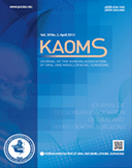Journal of the Korean Association of Oral and Maxillofacial Surgeons
- P-ISSN2234-7550
- E-ISSN2234-5930
- SCOPUS, KCI, ESCI
 ISSN : 2234-7550
ISSN : 2234-7550
3-Dimensional analysis for class III malocclusion patients with facial asymmetry
Abstract
Objectives: The aim of this study is to investigate the correlation between 2-dimensional (2D) cephalometric measurement and 3-dimensional (3D) cone beam computed tomography (CBCT) measurement, and to evaluate the availability of 3D analysis for asymmetry patients. Materials and Methods: A total of Twenty-seven patients were evaluated for facial asymmetry by photograph and cephalometric radiograph, and CBCT. The 14 measurements values were evaluated and those for 2D and 3D were compared. The patients were classified into two groups. Patients in group 1 were evaluated for symmetry in the middle 1/3 of the face and asymmetry in the lower 1/3 of the face, and those in group 2 for asymmetry of both the middle and lower 1/3 of the face. Results: In group 1, significant differences were observed in nine values out of 14 values. Values included three from anteroposterior cephalometric radiograph measurement values (cant and both body height) and six from lateral cephalometric radiographs (both ramus length, both lateral ramal inclination, and both gonial angles). In group 2, comparison between 2D and 3D showed significant difference in 10 factors. Values included four from anteroposterior cephalometric radiograph measurement values (both maxillary height, both body height) and six from lateral cephalometric radiographs (both ramus length, both lateral ramal inclination, and both gonial angles). Conclusion: Information from 2D analysis was inaccurate in several measurements. Therefore, in asymmetry patients, 3D analysis is useful in diagnosis of asymmetry.
- keywords
- Cephalometry, Cone-beam computed tomography, Analysis, Facial asymmetry
- Downloaded
- Viewed
- 0KCI Citations
- 0WOS Citations